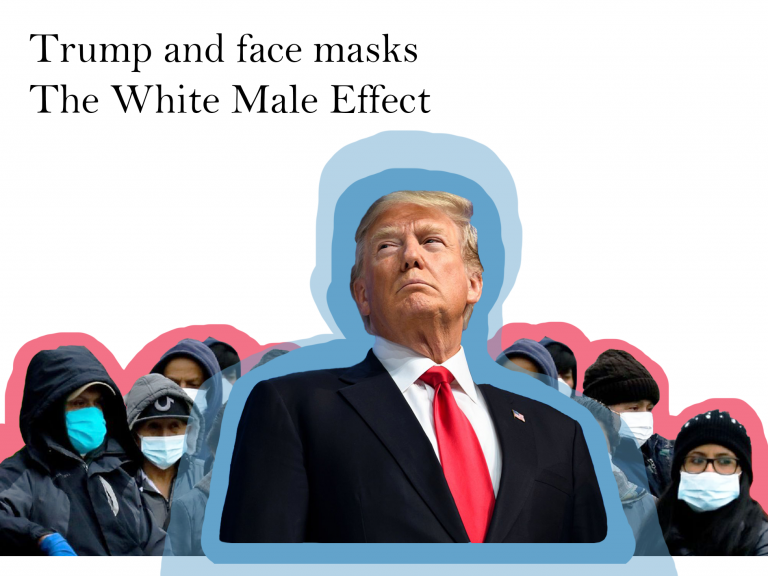
Margareta Durovcikova, PALS alumnus
On Trump, facemasks, race and risk-perception
In July, Donald Trump made worldwide news when he wore a face mask in public for the first time. Despite much of the world adopting face masks to stop the spread of COVID-19 and recommendations by the Centre for Disease Control, Trump has been vocal about not using a face mask. Can psychology help us understand his behaviour?
Why, of course! In the field of risk perception, there is a phenomenon called the “White male effect” which argues that white males tend to perceive risks like infectious diseases as less dangerous than females or people of colour (Finucane, Slovic, Mertz, Flynn, & Satterfield, 2000).
Since Trump is a white man, this would surely explain why he refuses to wear a mask. He does not see the risk of COVID-19 as high and so does not feel the need to protect himself and other people. But, as always in psychology, the explanation is not that simple.
Research shows that the “White male effect” is actually about worldviews rather than race or gender. Researchers in one study asked over 1,800 participants to evaluate environmental risks like global warming, gun risks like the impact of guns on societal safety and abortion risks. They found that worldviews were even better than race or gender at predicting how worried participants were about these risks. They categorised worldviews along 4 dimensions: hierarchical-egalitarian (whether they believe that resources should be allocated based some social classification or that anyone should have access to resources) and individualist-communitarian (whether they believe that individuals should depend on themselves and compete with others or they believe that individuals can depend on and help each other). Participants with highly hierarchical and individualistic views rated risks as overall lower than those with egalitarian and communitarian views (Kahan, Braman, Gastil, Slovic, & Mertz, 2007). But where does race fit into this explanation?
The authors of the study also showed that white males were more likely to hold hierarchical and individualist worldviews than women or people of colour. Similarly, black participants were disproportionately more likely to have egalitarian and communitarian worldviews. This was even when socioeconomic factors were taken into account.
Of course, white men are not born with individualistic and hierarchical worldviews, rather they adopt such views to protect their cultural identity. This is called identity-protective cognition and it can be explained using the example of gun ownership. A survey by the Pew Research Centre showed that about half of the white men asked reported owning a gun. This was twice the number of female women and non-white male gun owners and three times the number of non-white female gun owners. The survey also showed that men tend to be more interested in gun culture, e.g. they are more likely to go shooting or hunting than female gun owners (Pew Research Center, 2017). Clearly, gun ownership is important to many American white men and it is ultimately a part of their cultural identities. Now, the study on the white male effect found that individualistic and hierarchical white men saw guns as least dangerous, compared to other groups. Authors of the study argued that since gun ownership lets many white men occupy social roles, they become fearful that if laws about gun control became more restrictive, their cultural identity would be threatened. They adopt hierarchical and individualistic worldviews because such views let them keep their social roles and guns and ultimately protect their identities.
In broader terms, people with hierarchical and individualistic worldviews tend to be more risk sceptical than those with egalitarian and communitarian views. White men tend to have hierarchical and individualistic views and thus are risk sceptical because that does not challenge their place in society.
Yet, it is interesting to think about whether this would apply to other cultures and topics. Gun control is an especially controversial topic in the United States and perhaps these patterns of worldviews would not be found in other countries and cultures. Also, the study only looked at environmental, abortion and gun risks but if we examined different issues, maybe we would not find such big differences in risk perception of people with differing worldviews. Specifically, the risks around coronavirus and face masks has not been studied but it would be interesting to see how worldviews would interact with them. For now, we can hypothesize that since hierarchical and individualistic views lead to risk scepticism, these individuals may be less inclined to wear a face mask.
To answer our initial question – yes, psychology can somewhat explain why Donald Trump refused to wear a mask. Individuals with hierarchical and individualistic views tend to be risk sceptical and because white men are more likely than other groups to have such views, they tend to see different risks as less threatening. If we presume that Donald Trump has hierarchical and individualistic views because he is a white man, then we could argue that he refused to wear a mask because he is sceptical of the risk of coronavirus. But, of course, we have not tested Trump’s worldviews. Perhaps he has a superior respiratory system.
References
Finucane, M. L., Slovic, P., Mertz, C. K., Flynn, J., & Satterfield, T. A. (2000). Gender, race, and perceived risk: The “white male” effect. Health, Risk and Society, 2(2), 159–172.
Kahan, D. M., Braman, D., Gastil, J., Slovic, P., & Mertz, C. K. (2007). Culture and identity-protective cognition: Explaining the white-male effect in risk perception. Journal of Empirical Legal Studies, 4(3).
Pew Research Center. (2017). America’s Complex Relationship with Guns.
 Close
Close

